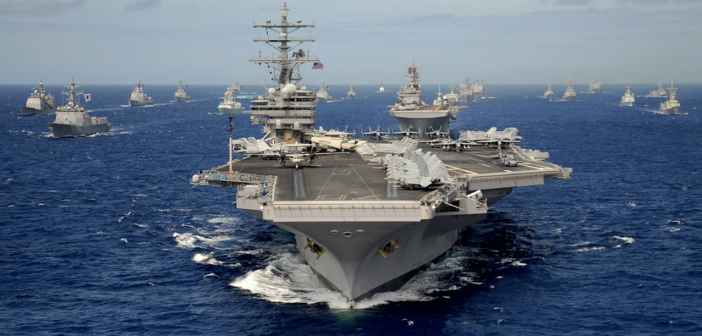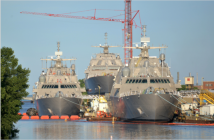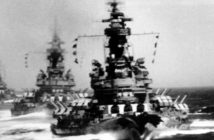By Chris Servello
Today’s debate over the size and make-up of our future Navy has all of the passion of a spirited sports debate. The never ending hot-takes remind me of the heated discussions I hear in the baseball off-season.
Is it possible that recent trends in baseball can help clarify future naval decision making? It’s not as far-fetched as it might seem. The evolution in how teams think about data and metrics has dramatically changed the sport. That same evolution should be incorporated by navalists and policy makers as they think and talk about the future fleet.
Somewhere around 1860 a baseball journalist named Henry Chadwick began keeping and publishing player statistics. Chadwick’s work changed the way baseball was viewed forever. And recently the baseball world has become even more enlightened — thanks to an assist from advanced stats dubbed “sabermetrics”.
Although the standard stats first conceived by Chadwick remain quite valuable, Bill James’ search for a more objective and comprehensive knowledge of the game changed the appreciation and understanding dramatically for those inside and outside of baseball.
Batting average, RBIs and home runs have given ground to more comprehensive and context providing calculations because the old stats hide a much richer story. The same is true for the Navy. While traditional metrics like ship count are still relevant, they don’t come close to fully reflecting naval power and ambition.
Beneficial only in its simplicity, ship count by itself increasingly falls short as a holistic indicator when discussing seapower outside of the naval service. When talked about publicly, even by our most articulate and capable navalists, the basic nature of the number overshadows the more essential points of difference–whether to increase the fleet’s size or capability to head off a growing threat, or to prioritize investments in game changing technologies or to keep the industrial base viable.
Recent writings on the 350, 355 or even 300 ship future fleet are incomplete, because the metric is too narrow and robs those who will decide the outcome of needed context.
This is not a new problem. Regardless of the party in power, Secretary of the Navy or Chief of Naval Operations, the centerpiece of our long term shipbuilding plan boils down to one consistent factor:hope. Leaders hope for a greater share of budget requests, for Congressional adds, and for a lack of attention to the fiscal math.
Naval leaders continue to lay out bold goals that downplay or even outright ignore political, economic, and industrial realities. When they can’t make the books balance in the Pentagon, they send plans to Congress asking for too few ships in the short term and use creative accounting to make the dream seem just plausible enough in the future to avoid ruffling feathers.
This is not the fault of anyone in particular. As used to be true in baseball, overly simplistic metrics perpetuate false choices and fuel vacuous debates. National security discourse would be more fulsome if we developed, like baseball did, a richer set of measures that capture the true complexity and make-up of the nation’s naval capability and capacity.
Most recently the Navy sought to put forward a naval power formula that accounted for readiness, capability and capacity, but it fell short because its accounting wasn’t complete enough and the resulting outcomes were too complex for the groups who need the information most.
A complex equation or set of variables doesn’t mean the resulting index should be complicated. In fact, the appropriate balance between a complex factoring of all that goes into fleet creation, paired with an easy to articulate outcome is exactly what we should be driving towards.
What should that precise calculus be? Honestly, I’m not entirely sure. Like WAR (wins above replacement), generally accepted as the single baseball stat used to judge an offensive or defensive player’s value, a new naval number should factor in a variety of individual metrics to produce an understood merit with meaning to all stakeholders.
My seapower index would factor in fleet readiness, technology, some combined accounting for manned and unmanned platforms—ships, subs and aircraft. It would also have budget, economy and industrial base variables, as well as an accounting for build, maintenance and people costs.
Consider the scene in Moneyball where Brad Pitt’s Billy Beane character meets with his scouts to discuss their shared problem in rebuilding the 2002 Oakland A’s. Many Pentagon meetings resemble that type of talking past each other because a common framework doesn’t yet exist.
The good news is the Navy is much closer to grasping this need for change than the baseball world was in 2002. Countless Pentagon-budgeting “bullpens” are working on this type of number, and have been for years. The challenge is to bring it forward and make it part of the public discussion as soon as possible.
Imagine the progress in dialogue— “currently we find ourselves at 7.2, but to compete with a growing Chinese fleet and new regional threats we need to raise the number the number to 7.5 over the next five years, and here are the ways we can do that… .
Today’s decision making demands the Bill James of naval power step out of the dugout and into the batter’s box. Anything less than an objective and comprehensive maritime measurement is a losing proposition.
The time to expand the appreciation and understanding of seapower and its associated costs is now. Batter-up.
Posted 12 Dec 2019
Chris Servello is a retired Navy public affairs officer and co-founder of Provision Advisors, a DC, Northern Virginia and Annapolis based communication and PR firm. He supports the Defense & Aerospace Report in digital marketing, brand growth and as a special events producer.
chris.servello@provisionadvisors.net



![CAVASSHIPS Podcast [Jun 12 21] Episode 1…We are Underway](https://defaeroreport.com/wp-content/uploads/2021/06/CAVASShips_Podcast-214x140.jpg)
